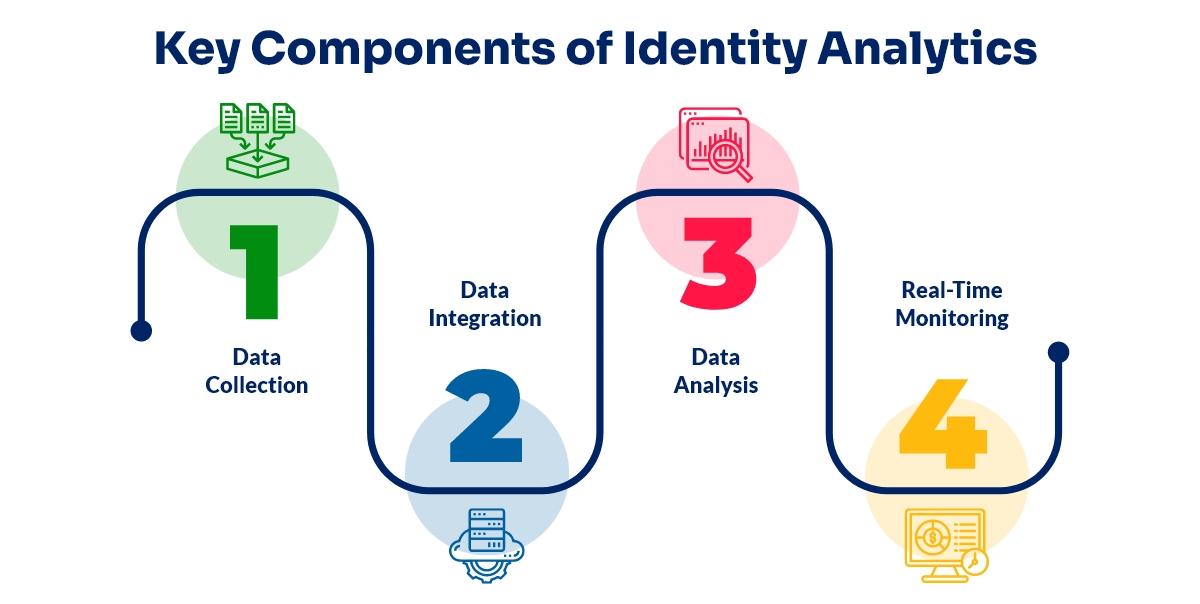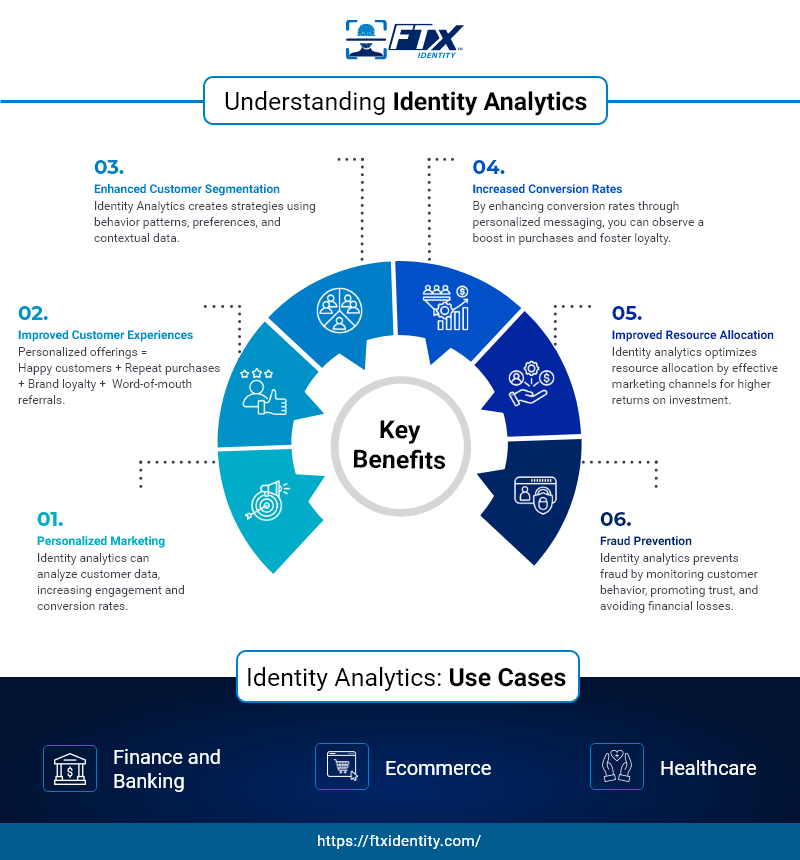Businesses are rapidly embracing cutting-edge tools to make the most of valuable customer information in an era where this data is the key to strategic decision-making.
Identity analytics is one such revolutionary approach that allows companies to not only understand who their customers are but also predicts their behaviors and needs.
In fact, the Identity Analytics Market is projected to grow significantly, with an estimated size of $1.40 billion in 2024. By 2029, the market is forecast to reach $4.91 billion, reflecting a compound annual growth rate (CAGR) of 28.51% during the forecast period (2024-2029).
This in-depth piece dives into identity analytics, highlighting its major role in boosting business success, enhancing customer experiences, and strengthening cybersecurity. We’ll break down its significance, examine its components, and showcase its practical uses in different industries.
Understanding the Importance of Identity Analytics

What is identity analytics exactly?
It’s a sophisticated way of using data analysis to check how identities are managed in a company. It’s about figuring out who’s who, making sure they’re real, and letting them access the right stuff at the right times and for the right reasons.
The Crucial Role of Identity Analytics in Modern Business
In the maze of data, picking out a customer’s voice is like searching for a needle in a haystack.
But when businesses nail this with identity analytics, the impact is huge. Personalizing marketing, suggesting products, and tailoring services on a one-to-one level can really boost conversion rates and profitability.
Identity analytics also plays a major role in security and compliance. By using unique identifiers and behavior patterns, businesses can flag and prevent fraudulent activities, safeguard sensitive data, and ensure regulatory adherence. This protective layer relies on smart use of identity analytics, making it a key player in risk management strategies.
Also, employee identity analytics can reveal insights about productivity, team dynamics, and even career paths. Mapping roles and responsibilities to how people perform and interact can help organizations streamline workflows, boost job satisfaction, and nurture talent development better than sticking to old-school HR methods.
How Identity Analytics Is Different from Traditional Approaches
At its core, identity analytics is like regular analytics; both aim to help make smart decisions.
However, here’s the thing:
Traditional analytics looks back, checking old data to spot trends and predict the future. Useful, yes, but it misses out on how people change.
Identity analytics, on the flip side, loves fresh data. It’s always updating profiles with the latest information, giving instant insights for real-time action and a big competitive edge.
Here’s another twist: depth. Traditional analytics groups customers broadly for marketing, while identity analytics dives deep for super-personalized plans.
The result? Not just a crowd, but a diverse mix of unique individuals, each with their own needs and preferences.
Key Components of Identity Analytics

To nail identity analytics, a company needs a solid framework: gather data, integrate, analyze, and monitor in real-time for quick decision-making.
Data Collection
Without data, identity analytics is useless. The first important step is to carefully collect as much relevant data as you can from different internal and external sources. It’s crucial to aim for information that’s not just broad but also dives deep into the details, helping to get a thorough and detailed understanding of each identity profile.
Data Integration
Data integration is like orchestrating a symphony where diverse data sources come together harmoniously, creating a unified and coherent dataset. This crucial process, although challenging given the vast array of sources involved, plays a pivotal role in maintaining the accuracy and relevance of data for informed decision-making and analysis.
Data Analysis
Once the data is integrated into the system, the next crucial step involves thorough analysis. Utilizing advanced analytic techniques like predictive modeling and machine learning becomes pivotal at this stage. These advanced methods really dig into the data, revealing complex patterns and valuable insights that could slip through with more traditional approaches.
Real-Time Monitoring
The last thing to do is to keep an eye on things regularly. By staying alert in real-time, you can quickly deal with big changes in behaviors or data patterns, making sure you manage things well and respond effectively.
Benefits of Implementing Identity Analytics

The implementation of identity analytics brings with it a bunch of benefits that are impossible to ignore.
Personalized Marketing
Identity analytics gives businesses the power to dive into customer data, crafting personalized marketing strategies that resonate on a personal level rather than generic segments. This increased personal touch not only boosts engagement but also enhances conversion rates, making a deeper impact on the audience.
Improved Customer Experiences
By delving into the intricacies of each customer’s needs and desires, businesses can craft personalized products and services that align perfectly with individual preferences. This customized approach not only fosters a distinctive and unforgettable customer journey but also cultivates strong brand loyalty, leading to increased repeat purchases and valuable word-of-mouth referrals.
Enhanced Customer Segmentation
Traditional segmentation methods in marketing typically involve grouping customers based on demographics such as age, gender, or location, as well as their purchase history.
However, identity analytics goes beyond this conventional approach.
It delves deeper into customer segmentation by considering their behavior patterns, preferences, and additional contextual data points. This advanced method allows businesses to create more personalized and targeted marketing strategies tailored to individual customer needs and interests.
Increased Conversion Rates
Enhanced targeting strategies, such as using customer segmentation based on demographics and behavior, combined with tailored messaging that resonates with individual preferences and needs, naturally lead to heightened conversion rates.
When customers feel their needs are recognized by a brand and met, it boosts purchase chances and fosters lasting loyalty.
Improved Resource Allocation
Identity analytics plays a crucial role in business strategy by analyzing customer data to optimize resource allocation. By identifying the most profitable customer segments and pinpointing the most effective marketing channels, companies can tailor their strategies for higher returns on investment. This data-driven approach ensures that each dollar spent is strategically utilized to boost profitability.
Fraud Prevention
By keeping a close eye on how customers behave, identity analytics uses smart algorithms to quickly and effectively spot and stop fraud, protecting people and businesses. This proactive approach helps avoid money problems and builds trust and loyalty with customers, creating a fresh approach to fighting fraud.
Industries Benefiting from Identity Analytics

Although the uses of identity analytics are broad, there are a few industries that could gain the most from it.
Finance and Banking
In the finance industry, known for its strict regulations and handling of high-stakes customer data, the use of identity analytics has proven to be highly beneficial.
This advanced tool is instrumental in effectively detecting fraudulent activities and ensuring compliance with regulatory standards. Moreover, identity analytics plays a major role in tailoring personalized financial solutions and services to meet the unique needs of clients.
The result? The enhancement of customer satisfaction and trust in the financial sector.
Healthcare
In healthcare, identity analytics plays a major role in enhancing patient care and treatment outcomes by offering detailed and insightful patient profiles. These profiles include a wide range of information, including medical history, treatment plans, and demographic data, allowing healthcare providers to deliver personalized and efficient care.
Moreover, identity analytics is instrumental in facilitating compliance with rigorous industry regulations like HIPAA (Health Insurance Portability and Accountability Act). By meticulously safeguarding and managing patient data, healthcare organizations ensure the confidentiality and integrity of sensitive information, ultimately promoting trust and accountability within the healthcare ecosystem.
Ecommerce
Ecommerce thrives on the personalization and customer engagement that identity analytics allows.
By using deep insights into customer behavior and preferences, ecommerce platforms can customize product suggestions, discounts, and marketing plans for a more personal shopping journey.
This kind of customization not only drives sales and loyalty but also builds lasting connections with the brand, encouraging repeat purchases and positive word-of-mouth buzz.
Identity Analytics in Cybersecurity
The cybersecurity game is intense, and identity analytics provides a powerful solution to defend against the increasing threat landscape.
User and Entity Behavior Analytics (UEBA)
UEBA (User and Entity Behavior Analytics) is a cutting-edge security approach that uses sophisticated identity analytics. It creates comprehensive profiles that meticulously record the typical behaviors of users and devices within a network environment.
By keeping a close eye on any changes from these set patterns, we can quickly spot security risks, allowing us to take proactive steps to reduce risks and improve cybersecurity.
Access Control
By using strong identity analytics solutions, companies can better keep an eye on and control access to important data and systems. This innovative technology lets organizations assign permissions based not only on set roles but also on past behaviors and access habits of users in the system.
Taking this broader approach not only boosts security but also improves data access governance, making sure the operational environment is solid and safe.
Compliance Monitoring
By setting up a structured way to track and analyze all system activities, a company can create a thorough audit trail. This method not only guarantees compliance with rules but also helps quickly spot and flag any possible breaches in real-time, boosting security and risk management efforts.
Conclusion
Identity analytics isn’t just a tech tool; it’s a strategic must-have. It amps up customer insights, boosts business efficiency, and safeguards crucial assets. This post only begins to unveil its potential, urging businesses to delve into this growing field.
With identity analytics, businesses can uncover the keys to their future success, one personalized interaction at a time.
To discover the benefits of FTx Identity for your business, reach out to us today to schedule a consultation and explore a demo!
